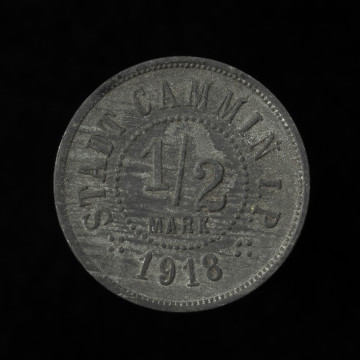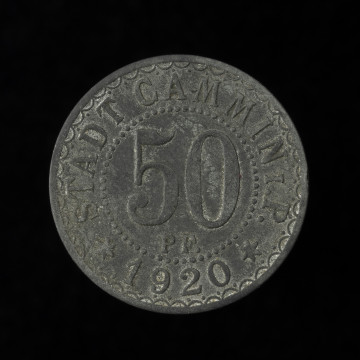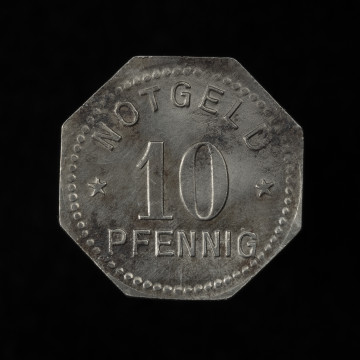
1/2 Mark (50 pfennig)
1918
National Museum in Szczecin
Part of the collection: Scrip
Putting money aside for a "rainy day" is generally considered a positive routine. However, in exceptional cases, hoarding can prove devastating for the money market. Such was the case in Germany during the First World War, when a specific type of money, namely metal coins of small denominations, was widely and extensively taken out of circulation. A large part of the German population participated in the purging of bullion and nickel coins from circulation, resulting in a rapid loss of circulating currency mass. The phenomenon of hoarding minor metal coins was observed earliest in the retail trade, where small payments paid with such coins tend to dominate. This scarcity was especially acute in the rural areas. In particular, as historical evidence provides, seaside towns and cities found themselves in a difficult situation during the summer season. At this time, the Baltic Sea attracted crowds of holidaymakers to whom local shopkeepers were unable to give change. Therefore, not only merchants but also local authorities tried to find a way out of this predicament. The decision to issue their own replacement money was also made by the authorities of the spa town of Kołobrzeg. In 1918, the company L. Chr. Lauer in Nuremberg, was commissioned to mint a batch of coins with a face value of 10 pfennig in iron. The coins are known in three varieties differing in the diameter of the mother-of-pearl rim at the edge of the coin. These differences are the result of the use of three different pairs of stamps, which was an outcome of rapid wear of the punches striking the hard iron discs. Regrettably, Kołobrzeg money quickly dropped out of circulation. Undoubtedly, collectors of replacement coins had a share in its dissapearance, but so did the tourists themselves, for whom the replacement money became one of the holiday souvenirs. Mieszko Pawłowski
Other names
10 Pfennig, Notgeld
Author / creator
Object type
token coin
Technique
coining
Material
iron
Origin / acquisition method
purchase
Creation time / dating
Creation / finding place
Owner
Muzeum Narodowe w Szczecinie (1945- )
Identification number
Location / status

1918
National Museum in Szczecin

1920
National Museum in Szczecin

1901 — 1925
National Museum in Szczecin
DISCOVER this TOPIC
Museum of King Jan III's Palace at Wilanów
DISCOVER this PATH
Educational path